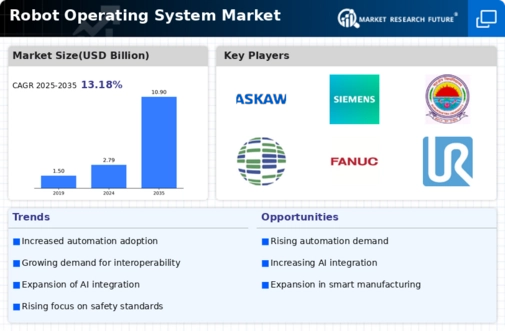Top Industry Leaders in the Robot Operating System Market
October 2023 -
Gecko Robotics, a robotics company that assists organizations in operating and maintaining their physical assets, has officially launched its Cantilever product. The solution integrates data from Gecko's various robotic, fixed-sensor, and partner systems into a software platform that enables unmatched analysis and decision-making regarding asset health. By combining data layers that were previously incompatible, Cantilever enables important customer decisions that boost uptime, reduce costs, and eliminate safety risks. Cantilever is intended to become the primary operating system for the physical world, enabling unprecedented data analysis and asset management.
October 2023 –
Recently, Nova Carter AMR, a comprehensive robotics platform that speeds up the creation and rollout of cutting-edge Autonomous Mobile Robots (AMRs), was introduced on the Segway-Ninebot official website. Nova Carter AMR was developed through a collaboration between Segway-Ninebot and NVIDIA. It includes high-computing modules, various sensors, robust autonomous navigation software and tools, as well as a very secure and dependable architecture. This provides strong support for the advancement and deployment of autonomous navigation technologies.
July 2023-
The Japanese home furnishings company Iris Ohyama will acquire the robotics startup Smile Robotics, which was founded at the University of Tokyo, according to Nikkei. Iris Ohyama's goal is to create customized robots for business clients as soon as 2025. Through Smile Robotics' operating system, which serves as the robot's brain, Iris Ohyama intends to adapt its machines to each customer's specific requirements. Additionally, Iris Ohyama hopes to advance the technology further, like enabling the remote operation of multiple robots simultaneously.
Some of Robot Operating System Companies Listed Below:
- Microsoft Corporation
- ABB Ltd
- KUKA AG
- Fanuc Corporation
- Yaskawa Electric Corporation
- iRobot Technologies
- Omron Corporation
- Husarion, Inc.
- Clearpath Robotics
- Cyberbotics Ltd
- Rethink Robotics
Strategic Maneuvers:
To remain ahead of the curve, leading players are adopting various approaches.
- Open-Source vs. Proprietary Offerings: Balancing the collaborative spirit of open-source ROS with the revenue potential of proprietary extensions and support services is a key challenge. Open Robotics Foundation fosters community development, while Canonical and ROS-I offer both open-source and commercial tools.
- Vertical Specialization: Catering to specific industry needs with tailored solutions strengthens market position. AWS RoboMaker excels in warehouse automation, while Microsoft Azure Robotics targets healthcare and logistics.
- Cloud Integration: Leveraging the scalability and flexibility of cloud platforms like AWS and Azure expands reach and simplifies development workflows.
- Standards and Interoperability: Promoting ROS as the de facto standard in the robotics industry encourages collaboration and fosters a diverse ecosystem of compatible hardware and software.
Market Share Determinants:
Several factors influence a company's market dominance.
- Community Engagement: Active participation in the ROS community, contributing to code development and documentation, builds trust and attracts developers. Open Robotics Foundation's leadership in this area is key to its success.
- Ecosystem Breadth: Offering a comprehensive range of tools and libraries covering simulation, perception, navigation, and control broadens appeal. ROS 2's modular architecture facilitates this approach.
- Ease of Use and Learning Curve: Providing intuitive interfaces, extensive documentation, and beginner-friendly tutorials lowers the barrier to entry and attracts new users. Canonical's Ubuntu LTS with ROS versions exemplifies this strategy.
- Hardware Compatibility: Supporting a wide range of robotic platforms and sensors expands developer choice and accelerates adoption. ROS 2's focus on hardware abstraction enhances compatibility.
- Real-Time Performance and Reliability: Ensuring robust performance and real-time responsiveness is crucial for mission-critical applications. ROS 2's design prioritizes these aspects.
New Entrants and the Rising Tide:
While established players hold sway, innovative startups are carving their own paths.
- Ignition Robotics: Offering a commercial ROS 2 distribution with advanced features and enterprise-grade support.
- Blackfin Robotics: Specializing in ROS-based autonomous mobile robots for logistics and warehouse automation.
- Tier IV: Developing ROS-based autonomous driving software for various vehicles and environments.
- Realtime Robotics: Pioneering ROS 2 integration with real-time operating systems for high-performance robotics applications.
Investment Trends Shaping the Future:
Companies are pouring resources into several key areas.
- Artificial Intelligence (AI) and Machine Learning (ML): Integrating AI and ML into ROS for improved perception, decision-making, and adaptation capabilities is a critical focus. Ignition Robotics' AI-powered navigation features exemplify this trend.
- Cloud Robotics: Expanding ROS cloud capabilities unlocks scalability, remote management, and data-driven insights. AWS RoboMaker and Microsoft Azure Robotics are leading the charge in this area.
- Edge Computing: Enabling intelligent robots at the edge of networks reduces latency and improves responsiveness in critical applications. Realtime Robotics' integration with real-time operating systems empowers edge-based robotics.










